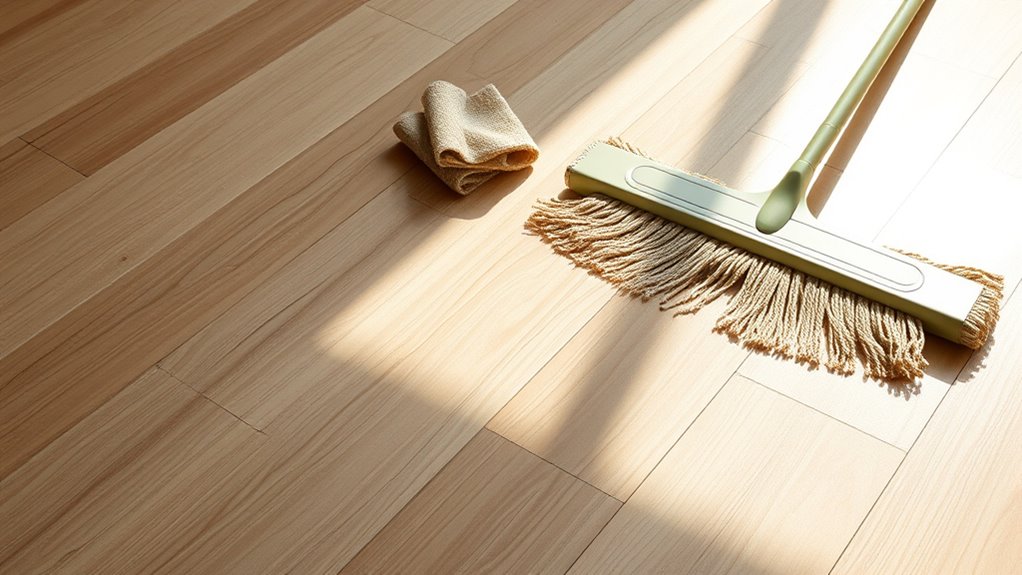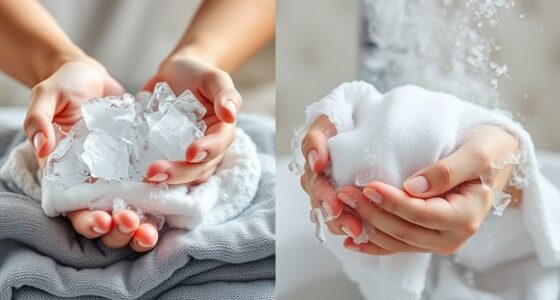To care for your floors eco-friendly, choose natural, non-toxic solutions tailored to each material. For hardwoods, use vinegar-water or green cleaners, avoiding excess moisture. Laminate and vinyl floors benefit from microfiber mops and gentle products. Clean tile with baking soda mixtures, while cork needs simple vacuuming and damp cloths. Support sustainable tools like biodegradable pads and reusable cloths to minimize waste. Keep your flooring healthy and eco-conscious—learn more about specific tips for each surface as you continue.
Key Takeaways
- Use vinegar-water solutions or eco-friendly cleaners for hardwood floors, avoiding excess moisture.
- Clean laminate and vinyl floors with microfiber mops and gentle, sustainable cleaning products.
- Scrub tile and stone surfaces with baking soda-water mixtures or eco-conscious commercial cleaners.
- Maintain cork floors with vacuuming and damp microfiber cloths to prevent chemical exposure.
- Incorporate biodegradable mop pads and reusable cloths for all flooring types to reduce waste.

Are you looking for ways to keep your floors spotless while reducing your environmental impact? If so, focusing on eco-friendly floor care by material can make a significant difference. The key is choosing sustainable cleaning methods that align with your values and prioritize non-toxic solutions. When you opt for sustainable cleaning, you’re not only protecting your home but also supporting a healthier planet. Using non-toxic solutions means avoiding harsh chemicals that can harm your indoor air quality, pets, and family. Instead, you can turn to natural alternatives that are just as effective but kinder to the environment.
Choosing eco-friendly floor care methods protects your home and the planet with natural, non-toxic solutions.
Different flooring materials require tailored cleaning approaches that respect their unique compositions. For hardwood floors, for instance, you want to avoid excessive moisture that could warp or damage the wood. Use a damp cloth or mop with a mixture of vinegar and water, or select a commercial product labeled as eco-friendly and non-toxic. These solutions clean effectively without introducing harmful chemicals into your home. Laminate and vinyl floors also benefit from gentle, sustainable cleaning; a soft microfiber mop combined with a mild, eco-conscious cleaning solution works well. It’s important to steer clear of abrasive cleaners or those containing phosphates and volatile organic compounds (VOCs), which can degrade indoor air quality and harm the environment. Incorporating eco-friendly cleaning tools, such as biodegradable mop heads and reusable cloths, further supports environmentally conscious practices.
Tile and stone floors are durable but can still benefit from eco-friendly cleaning practices. Use a mixture of baking soda and water for scrubbing, or opt for commercially available green cleaners designed specifically for these surfaces. These solutions are effective at removing dirt and grime without leaving behind chemical residues. Cork floors, known for their sustainability and comfort, require gentle cleaning as well. A simple vacuum followed by a damp microfiber cloth ensures they stay in good shape without unnecessary chemical exposure. Additionally, for all materials, incorporating reusable cleaning cloths and biodegradable mop pads reduces waste and supports sustainable cleaning practices.
Investing in eco-friendly cleaning tools also enhances your efforts. Choose biodegradable mop heads, natural fiber brushes, and reusable cloths to minimize your ecological footprint. Remember that regular maintenance, like sweeping or vacuuming, prevents the buildup of dirt and reduces the need for frequent deep cleans with chemicals. Moreover, using air purifiers with HEPA filters can improve indoor air quality by removing airborne pollutants and allergens, making your space healthier. Overall, sustainable cleaning and non-toxic solutions offer a practical way to care for your floors while respecting the environment. By selecting the right methods tailored to each material, you ensure your floors stay beautiful and clean without compromising health or sustainability. Making these mindful choices not only benefits your home but also contributes to a healthier planet for everyone.
Frequently Asked Questions
Are Eco-Friendly Floor Care Products Safe for Pets?
Eco-friendly floor care products are generally safe for pets, but you should still check for potential pet toxin risks. Many eco-friendly options avoid harsh chemicals, reducing allergy considerations and poisoning risks. Always read labels carefully to verify products are non-toxic and suitable for homes with animals. If you’re unsure, consult your veterinarian to confirm the safety of specific products, ensuring your furry friends stay healthy and safe.
How Often Should Eco-Friendly Floor Cleaning Be Performed?
You should clean your floors with eco-friendly products based on your specific needs and foot traffic. Generally, follow the frequency guidelines for your flooring type, such as sweeping daily or mopping weekly. For high-traffic areas, increase cleaning frequency to maintain cleanliness and prevent dirt buildup. Creating a consistent cleaning schedule helps keep your space healthy and eco-friendly, ensuring your floors stay fresh without overusing products or water.
Can Eco-Friendly Cleaners Remove Stubborn Stains Effectively?
Eco-friendly cleaners can be quite effective at stain removal, especially when you choose products designed for stubborn stains. To maximize cleaning effectiveness, apply the cleaner directly to the stain and let it sit for a few minutes before scrubbing gently. While they might not always match the potency of chemical cleaners, many eco-friendly options work well on common stains, helping you achieve a clean, eco-conscious floor.
Are There Eco-Friendly Options for Deep Cleaning Carpets?
Yes, you can find eco-friendly options for deep cleaning carpets. Look for natural fiber-based cleaners that use biodegradable solutions, which effectively remove dirt and stains without harsh chemicals. These products penetrate deep into your carpet fibers, lifting grime while being safe for your family and the environment. Regular use of such eco-friendly deep cleaning methods helps maintain a fresh, clean carpet while reducing your ecological footprint.
What Are the Best Eco-Friendly Mop Types for Different Floors?
You should consider microfiber mops and steam mops for eco-friendly floor cleaning. Microfiber mops are versatile and use less water and chemicals, making them ideal for hardwood, tile, and laminate floors. Steam mops harness natural heat to sanitize without harsh cleaners, perfect for sealed floors. Both options reduce chemical use and water waste, helping you maintain a clean home while supporting environmental sustainability.
Conclusion
By choosing eco-friendly floor care methods, you not only protect your home and the environment but also find that sustainability often coincides with better results. It’s a coincidence how natural ingredients leave your floors looking spotless, and your conscience feeling clear. When you prioritize eco-friendly products, you might just discover that caring for your floors naturally aligns with caring for the planet—making every clean moment a happy coincidence.










